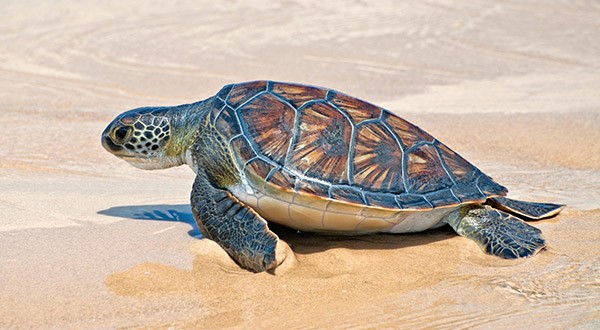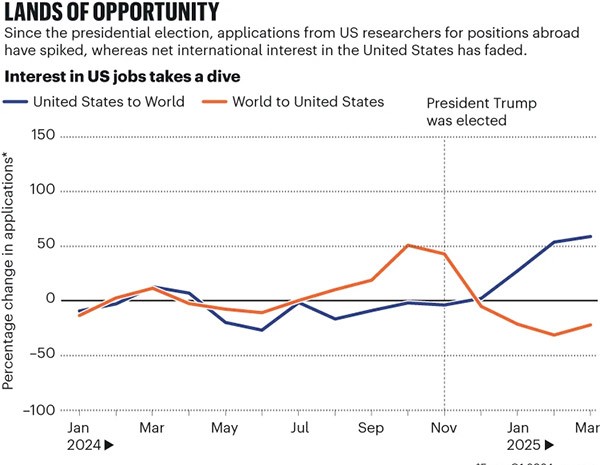You have full access to this article via your institution.
Hello Nature readers, would you like to get this Briefing in your inbox free every day? Sign up here.

Green turtles (Chelonia mydas) like this one live in some of the safest locations for sea turtles, while leatherback turtles (Dermochelys coriacea) live in some of the riskiest areas. (Itsik Marom/Alamy)
In many places, endangered sea turtles are bouncing back. A survey of turtle researchers in 50 countries found that on average, numbers of nesting females have increased since 2011, and threats such as hunting, pollution and habitat loss are declining in more than half of the regions analysed. Still, things are getting worse in some locations, with the biggest problem being entanglement in fishing nets. “Overall, the sea turtle story is one of the real conservation success stories,” says ecologist Stuart Pimm.
The Associated Press | 4 min read
Reference: Endangered Species Research paper
Wild chimpanzees (Pan troglodytes verus) have been spotted gathering to share mildly alcoholic fruits. Researchers caught small groups of chimps of all ages and sexes sharing fermented African breadfruit on several occasions. The fruit’s alcohol content isn’t high enough to get the chimps drunk, but they were seen to choose fermented pieces over others. “Chimps don’t share food all the time, so this behaviour with fermented fruit might be important,” says ecologist Kimberley Hockings. It “could be the early evolutionary stages of feasting”.
Reference: Current Biology paper
A hugely influential women’s-health project has lost much of its funding as part of the cuts ordered by the Trump administration. The Women’s Health Initiative is the largest National Institutes of Health effort focusing on long-neglected issues such as menopause, osteoporosis and healthy ageing. “This trial just taught us an immense amount about prevention of disease in women,” says gynecological oncologist Sarah Temkin. “This is a terrible, terrible thing to have happen.”
An analysis of Springer Nature’s jobs-board data suggests that US scientists are looking abroad as the country’s scientific enterprise reels from the impact of President Donald Trump’s administration. For example, applications by US scientists to jobs in Europe increased by 32% in March compared with the same month a year earlier. By contrast, applications to US institutions from researchers in Europe dropped by 41%. But many researchers outside the US say their countries aren’t equipped to capitalize on the opportunity, with low salaries, job security and lackluster funding among their concerns.
Nature’s news team is editorially independent of its publisher, Springer Nature — as is this newsletter.

Features & opinion
Many climate-change survival scenarios depend on us finding a way to remove enormous amounts of CO2 from the atmosphere, but there are plenty of open questions about how this can be made technologically and economically possible. The cheapest carbon-removal strategy: grow more forests and keep them healthy. But companies are working on several less quotidian options, such as pumping carbon out of the air and stashing it underground, adding things to oceans or croplands to enable them to absorb more CO2, or building power plants that burn biomass and permanently store the carbon emissions. All have potential downsides, including the concern that they might be used to justify the continued burning of fossil fuels. “We are really trying really hard not to burden the next generation with the enormous impacts of climate change,” says Earth-system scientist Wolfgang Lucht. “We should also not burden them with having to implement planetary-scale carbon removal.”
“If no one talks about climate change, people become less likely to talk about it because it is perceived as a taboo topic,” says climate-communication researcher Margaret Orr. On the flipside, discussing climate change can spark interest and action. Orr co-authored a recent study on what stops people from grasping the climate-conversation nettle, and she suggests adding “little sprinkles” of climate chat that might resonate with your listener — for example, mention its impact on ingredients with a friend who loves cooking. And when it comes to social media, think of the ‘lurkers’ rather than focusing on the blowhards. “Your effort to spread truth about climate change is likely to reach them without you ever knowing it.”
Reference: PLOS Climate paper
The final episode of the podcast miniseries What’s in a name explores how the terminology used in physics can serve to confuse rather than clarify. “Physicists and mathematicians, unlike a lot of other scientists, literally have to make stuff up sometimes,” quantum physicist Ian Durham tells the Nature Podcast. “Because they need a way to describe something extremely complex.” But the images that chosen terms evoke don’t always correspond to reality: electrons don’t ‘spin’ and ‘dark matter’ isn’t dark (and might not be made of matter). In those cases, the names we use can inadvertently send scientists down very specific research avenues while distracting them from others.
Nature Podcast | 33 min listen
Subscribe to the Nature Podcast on Apple Podcasts, Spotify or YouTube Music, or use the RSS feed.
Image of the week

On its second flyby of an asteroid, NASA’s Lucy spacecraft took a close look at the roughly 150 million-year-old fragment Donaldjohanson. The craft took a series of images (shown here as a timelapse) as it flew approximately 960 kilometres from the rock. The fragment’s unusual shape — similar to a peanut or a bowling pin — suggests that it formed from the collision of two smaller bodies. First discovered in 1981, the rock is named after palaeoanthropologist Donald Johanson, who discovered the hominin fossil Lucy, the spacecraft’s namesake, in 1974. (NASA Press Release | 4 min read) (NASA/Goddard/SwRI/Johns Hopkins APL)
Today I’m still in the midst of the post-holiday transition from nature to the city — a journey richly described by writer and naturalist Craig Childs as “the wonder killer”. One way to ease the process and tap back into the wonder is listening to an episode of Radio Lento, a podcast of high-quality environmental soundscapes recorded in the United Kingdom.
While I take an audio journey to a rocky West Somerset beach, why not send me your feedback on this newsletter? Your e-mails are always welcome at [email protected].
Thanks for reading,
Flora Graham, senior editor, Nature Briefing
With contributions by Jacob Smith
Want more? Sign up to our other free Nature Briefing newsletters:
• Nature Briefing: Careers — insights, advice and award-winning journalism to help you optimize your working life
• Nature Briefing: Microbiology — the most abundant living entities on our planet — microorganisms — and the role they play in health, the environment and food systems
• Nature Briefing: Anthropocene — climate change, biodiversity, sustainability and geoengineering
• Nature Briefing: AI & Robotics — 100% written by humans, of course
• Nature Briefing: Cancer — a weekly newsletter written with cancer researchers in mind
• Nature Briefing: Translational Research — covers biotechnology, drug discovery and pharma


